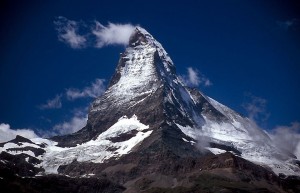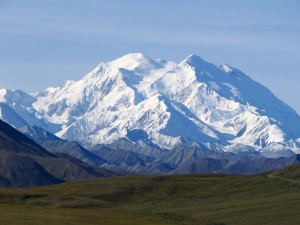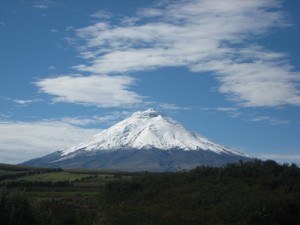Five Iconic Mountains Threatened By Climate Change
Glacial melt. Invasive species. Mudslides. Erosion. Mountains around the world are seeing major changes accelerated by a warming planet. Mountains represent 25% of the earth’s surface and host 13% of the world’s population. Warming-fueled changes are threatening sensitive ecosystems, water resources, climbing routes, and, in turn, the way of life in local communities (see “As Warming Glaciers Retreat, What Will Become of Peru’s Cordillera Blanca and Its Water Supply?”)
Below is a list of five iconic mountains — known for their cultural, resource, and recreational significance — that are being directly impacted by climate change.
1. Mount Everest
.jpg) As the highest mountain in the world, Everest is widely known. But this iconic mountain, located in the Himalayas, has changed dramatically in recent years as snow and ice melt makes climbing routes more dangerous. Some locals fear that the mountain will soon be unclimbable:
As the highest mountain in the world, Everest is widely known. But this iconic mountain, located in the Himalayas, has changed dramatically in recent years as snow and ice melt makes climbing routes more dangerous. Some locals fear that the mountain will soon be unclimbable:
Apa Sherpa, the Nepali climber who has conquered Mount Everest a record 21 times, said he was disturbed by the lack of snow on the world’s highest peak, caused by rising temperatures.
“In 1989 when I first climbed Everest there was a lot of snow and ice but now most of it has just become bare rock. That, as a result, is causing more rockfalls which is a danger to the climbers,” he told AFP.
“Also, climbing is becoming more difficult because when you are on a mountain you can wear crampons but it’s very dangerous and very slippery to walk on bare rock with crampons.”
According to the International Center for Integrated Mountain Development, glaciers in the Himalayas have declined by 21 percent in the last three decades. And this isn’t just bad for climbers and for local tourism. It’s a massive threat to 1.3 billion people living downstream from this important water source.
2. The Matterhorn
 The Matterhorn is one of Europe’s tallest mountains. Located in the Alps, it offers climbers dozens of unique technical climbs. (And for someone not looking to be one of hundreds who’ve died on the mountain, there’s also a cable car). However, climate change is threatening both climbers and cable car riders as warming temperatures cause the mountain to break apart:
The Matterhorn is one of Europe’s tallest mountains. Located in the Alps, it offers climbers dozens of unique technical climbs. (And for someone not looking to be one of hundreds who’ve died on the mountain, there’s also a cable car). However, climate change is threatening both climbers and cable car riders as warming temperatures cause the mountain to break apart:
Researchers from the University of Zurich, who have been studying the mountain closely since 2007, say melting water is permeating exposed cracks and crevices on the 4,478m (14,690ft) mountain, which straddles the Swiss-Italian boarder. Subsequent cycles of freezing and thawing in these gaps are creating subtle movements under the rock surface, causing ever-widening fissures with the result that lumps of rock are falling off, the researchers say.
The crumbling of the Matterhorn is symptomatic of what’s happening in the rest of the Alps, say the report’s authors. That could mean major safety hazards for cable cars and hiking routes on other mountains in the region.
3. Mount McKinley
 Also known as Denali, Mount McKinley is the highest peak in North America. Located in Alaska’s Denali National Park, the popular mountain attracts some of the most experienced climbers in the world.
Also known as Denali, Mount McKinley is the highest peak in North America. Located in Alaska’s Denali National Park, the popular mountain attracts some of the most experienced climbers in the world.
However, Alaska is warming much faster than the rest of the United States. According to the U.S. Global Research Program, Alaska has seen temperatures increase at twice the rate of the lower 48 states. That’s causing glaciers to retreat, helping invasive species thrive, and accelerating thawing permafrost — steadily changing the landscape around Denali. The National Park Service warned of the consequences to park visitors in a recent report:
Shrinking glaciers and heavy snowmelt make it more likely that the frozen walls of glacial lakes will fail, triggering flash floods and debris flows that could endanger park workers and visitors, the report said.
At Denali National Park, one of the state’s top tourist destinations, once-frozen hillsides are unleashing cascades of mud as they thaw, causing problems along the lone road that snakes through the heart of the park.
Denali may not be crumbling like the Matterhorn or melting as quickly as Everest, but the mountain and the surrounding landscape are experiencing noticeable changes in a very short period of time — and those changes are only accelerating.
4. Kilimanjaro
.jpg) Tanzania is host to Africa’s highest mountain, Kilimanjaro. It’s made up of three inactive volcanoes topped with ice and snow. But experts warn Kilimanjaro’s glacial cap could completely disappear in the next two decades.
Tanzania is host to Africa’s highest mountain, Kilimanjaro. It’s made up of three inactive volcanoes topped with ice and snow. But experts warn Kilimanjaro’s glacial cap could completely disappear in the next two decades.
Researchers at Ohio State University say that Kilimajaro has lost 85% of its ice mass since 1912, with 26% of ice melting in the last decade alone:
“We present additional evidence that the combination of processes driving the current shrinking and thinning of Kilimanjaro’s ice fields is unique within an 11,700-year perspective. If current climatological conditions are sustained, the ice fields atop Kilimanjaro and on its flanks will likely disappear within several decades,” they say.
If conditions persist, and warmer temperatures continue to melt more ice than falls in the form of snow, then there is a “strong likelihood that the ice field will disappear within a decade or two,” the authors conclude.
Dwindling, unstable ice on Kilimanjaro wouldn’t just impact climbability. It would have a devastating impact on the communities surrounding the mountain that rely upon the shrinking resource for water.
5. Cotopaxi
 Seen in the distant landscape from Ecuador’s capital, Quito, Cotopaxi is one of the highest active volcanoes in the world. It has become a popular attraction for hikers, and plays a role in the water resources for 2.4 million people in nearby cities.
Seen in the distant landscape from Ecuador’s capital, Quito, Cotopaxi is one of the highest active volcanoes in the world. It has become a popular attraction for hikers, and plays a role in the water resources for 2.4 million people in nearby cities.
But this “glaciovolcano” may soon just be a “volcano” if warming persists. Climatologists and Glaciologists say Cotopaxi has lost 40% of its ice cover in the last 35 years:
Mathias Vuille, a climatologist from New York State University at Albany, says “yearly variations can be best explained by the El Nino/La Nina cycle, but the long-term trend of retreating glaciers is best explained by anthropogenic climate change”.
Mr Vuille and others working in the Andes have tracked temperature changes in the last 70 years to show that there has been an average warming of near-surface air temperatures of around 0.10C per decade and an overall increase of 0.68C since 1939.
Experts estimate that Cotopaxi and the glacier on nearby Antisana contribute between 2% and 10% to local water supplies. Even on the low end, these glaciers supply an abundance of water to Andean grasslands, which soak up and regulate water for local communities and sensitive ecosystems.
Below is a list of five iconic mountains — known for their cultural, resource, and recreational significance — that are being directly impacted by climate change.
1. Mount Everest
.jpg) As the highest mountain in the world, Everest is widely known. But this iconic mountain, located in the Himalayas, has changed dramatically in recent years as snow and ice melt makes climbing routes more dangerous. Some locals fear that the mountain will soon be unclimbable:
As the highest mountain in the world, Everest is widely known. But this iconic mountain, located in the Himalayas, has changed dramatically in recent years as snow and ice melt makes climbing routes more dangerous. Some locals fear that the mountain will soon be unclimbable:Apa Sherpa, the Nepali climber who has conquered Mount Everest a record 21 times, said he was disturbed by the lack of snow on the world’s highest peak, caused by rising temperatures.
“In 1989 when I first climbed Everest there was a lot of snow and ice but now most of it has just become bare rock. That, as a result, is causing more rockfalls which is a danger to the climbers,” he told AFP.
“Also, climbing is becoming more difficult because when you are on a mountain you can wear crampons but it’s very dangerous and very slippery to walk on bare rock with crampons.”
According to the International Center for Integrated Mountain Development, glaciers in the Himalayas have declined by 21 percent in the last three decades. And this isn’t just bad for climbers and for local tourism. It’s a massive threat to 1.3 billion people living downstream from this important water source.
2. The Matterhorn
 The Matterhorn is one of Europe’s tallest mountains. Located in the Alps, it offers climbers dozens of unique technical climbs. (And for someone not looking to be one of hundreds who’ve died on the mountain, there’s also a cable car). However, climate change is threatening both climbers and cable car riders as warming temperatures cause the mountain to break apart:
The Matterhorn is one of Europe’s tallest mountains. Located in the Alps, it offers climbers dozens of unique technical climbs. (And for someone not looking to be one of hundreds who’ve died on the mountain, there’s also a cable car). However, climate change is threatening both climbers and cable car riders as warming temperatures cause the mountain to break apart:Researchers from the University of Zurich, who have been studying the mountain closely since 2007, say melting water is permeating exposed cracks and crevices on the 4,478m (14,690ft) mountain, which straddles the Swiss-Italian boarder. Subsequent cycles of freezing and thawing in these gaps are creating subtle movements under the rock surface, causing ever-widening fissures with the result that lumps of rock are falling off, the researchers say.
The crumbling of the Matterhorn is symptomatic of what’s happening in the rest of the Alps, say the report’s authors. That could mean major safety hazards for cable cars and hiking routes on other mountains in the region.
3. Mount McKinley
 Also known as Denali, Mount McKinley is the highest peak in North America. Located in Alaska’s Denali National Park, the popular mountain attracts some of the most experienced climbers in the world.
Also known as Denali, Mount McKinley is the highest peak in North America. Located in Alaska’s Denali National Park, the popular mountain attracts some of the most experienced climbers in the world.However, Alaska is warming much faster than the rest of the United States. According to the U.S. Global Research Program, Alaska has seen temperatures increase at twice the rate of the lower 48 states. That’s causing glaciers to retreat, helping invasive species thrive, and accelerating thawing permafrost — steadily changing the landscape around Denali. The National Park Service warned of the consequences to park visitors in a recent report:
Shrinking glaciers and heavy snowmelt make it more likely that the frozen walls of glacial lakes will fail, triggering flash floods and debris flows that could endanger park workers and visitors, the report said.
At Denali National Park, one of the state’s top tourist destinations, once-frozen hillsides are unleashing cascades of mud as they thaw, causing problems along the lone road that snakes through the heart of the park.
Denali may not be crumbling like the Matterhorn or melting as quickly as Everest, but the mountain and the surrounding landscape are experiencing noticeable changes in a very short period of time — and those changes are only accelerating.
4. Kilimanjaro
.jpg) Tanzania is host to Africa’s highest mountain, Kilimanjaro. It’s made up of three inactive volcanoes topped with ice and snow. But experts warn Kilimanjaro’s glacial cap could completely disappear in the next two decades.
Tanzania is host to Africa’s highest mountain, Kilimanjaro. It’s made up of three inactive volcanoes topped with ice and snow. But experts warn Kilimanjaro’s glacial cap could completely disappear in the next two decades.Researchers at Ohio State University say that Kilimajaro has lost 85% of its ice mass since 1912, with 26% of ice melting in the last decade alone:
“We present additional evidence that the combination of processes driving the current shrinking and thinning of Kilimanjaro’s ice fields is unique within an 11,700-year perspective. If current climatological conditions are sustained, the ice fields atop Kilimanjaro and on its flanks will likely disappear within several decades,” they say.
If conditions persist, and warmer temperatures continue to melt more ice than falls in the form of snow, then there is a “strong likelihood that the ice field will disappear within a decade or two,” the authors conclude.
Dwindling, unstable ice on Kilimanjaro wouldn’t just impact climbability. It would have a devastating impact on the communities surrounding the mountain that rely upon the shrinking resource for water.
5. Cotopaxi
 Seen in the distant landscape from Ecuador’s capital, Quito, Cotopaxi is one of the highest active volcanoes in the world. It has become a popular attraction for hikers, and plays a role in the water resources for 2.4 million people in nearby cities.
Seen in the distant landscape from Ecuador’s capital, Quito, Cotopaxi is one of the highest active volcanoes in the world. It has become a popular attraction for hikers, and plays a role in the water resources for 2.4 million people in nearby cities.But this “glaciovolcano” may soon just be a “volcano” if warming persists. Climatologists and Glaciologists say Cotopaxi has lost 40% of its ice cover in the last 35 years:
Mathias Vuille, a climatologist from New York State University at Albany, says “yearly variations can be best explained by the El Nino/La Nina cycle, but the long-term trend of retreating glaciers is best explained by anthropogenic climate change”.
Mr Vuille and others working in the Andes have tracked temperature changes in the last 70 years to show that there has been an average warming of near-surface air temperatures of around 0.10C per decade and an overall increase of 0.68C since 1939.
Experts estimate that Cotopaxi and the glacier on nearby Antisana contribute between 2% and 10% to local water supplies. Even on the low end, these glaciers supply an abundance of water to Andean grasslands, which soak up and regulate water for local communities and sensitive ecosystems.
You can return to the main Market News page, or press the Back button on your browser.

